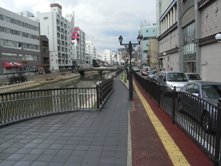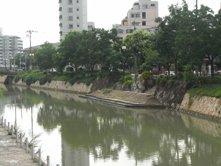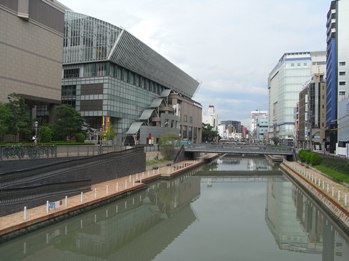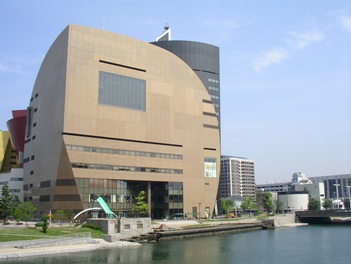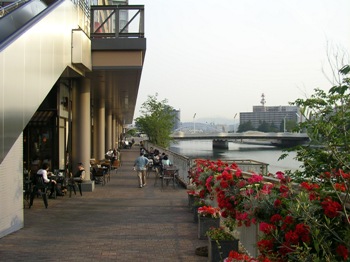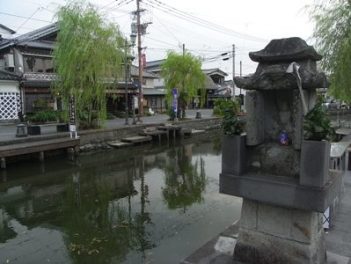
< World's WATERFRONT:JAPAN Category: Kyushu >
|
Photo by Michiya Tannai, Aug. 2008
|
Hakata River running through Hakata and Tenjin districts at the center of Fukuoka City gave off a terrible smell and gas in the past due to deteriorated water quality as it was a tidal river without flow. Therefore, reclamation was discussed from time to time. In 1990, Fukuoka City developed the “Hakata River Dream Corridor Project” (“Hakata River Improvement Concept”), and this environmental improvement (including waterfront improvement) project has been promoted while urban area redevelopment project is conducted in addition to river environment improvement.
By JRRN-secre | Category: Community and urban river restoration,Kyushu | Comment(0) | Trackback(0) |
Date: 2012.01.05 16:18
|
Photo by Norio Nagai, May. 2008
|
Murasaki River flowing through the inner-city area of Kitakyushu City was listed as a “My Town, My River Improvement Project (A Waterfront Plan project)” river in 1988. Since then, urban infrastructure improvement including river and surrounding urban development has been conducted. In the Murasaki River Bashaku district, various approaches are adopted, which include not only flood control projects but also waterfront park and road improvement and urban district vitalization to enhance private developers’ potentiality to create a town centering on the river.
By JRRN-secre | Category: Community and urban river restoration,Kyushu | Comment(0) | Trackback(0) |
Date: 2012.01.05 16:18
The Kokubun and Hayato areas lying on each side of Amori River were targeted in the "Kokubun, Hayato Technopolis plan" in March 1984 and river improvement work such as invitation of advanced technology developing companies was promoted.
For Amori River, which is an important water/green axis in this Kokubun, Hayato Technopolis district, a "hometown river model project" (the current hometown river improvement project) was started in June 1988 with the catch phrase of "From the past to the future, Amori River, a river of meetings and relaxation," while the water control safety degree between unimproved zones was raised. By taking advantage of the historical features from the age of myth and rich nature, the waterfront space has been improved to become a good place to meet people.
By JRRN-secre | Category: Community and urban river restoration,Kyushu | Comment(0) | Trackback(0) |
Date: 2011.09.10 19:00
Bachi River runs through the center of Kurosaki, flowing into Dokai Bay. In the past, people enjoyed fishing for crucian carps and children gathered and played at the waterfront. With the great flood damage in 1953 as a trigger, river improvement work to cast concrete in the three faces was conducted and the river became a drainage canal and was ignored by local residents.
Later, a river restoration project was started in 1995 and a research group was established to make best use of citizens' opinions. As a result of discussions with various parties concerned with the future of the river, the "Bachi River Renaissance Plan, Basic Concept" was drawn up.
Today, fireflies have returned to Bachi River and from 2006 on "Bachi River firefly festival" has been held. Bachi River won the "Handmade Hometown Award" in 2004.
By JRRN-secre | Category: Community and urban river restoration,Kyushu | Comment(0) | Trackback(0) |
Date: 2011.09.10 18:59
Ushiroda River, which runs through the center of Miyazaki City, was used to carry a lot of human sewage as a result of the rapid urbanization and the water environment was so deteriorated that the water gave off a terrible smell.
Therefore, it was changed into a culvert as the Ushiroda main trunk line, on which a greenway park was constructed. Moreover, a babbling stream waterway was constructed in the greenway park by using the high-quality treated water from the sewage treatment plant under the "Aqua-park Model Project".
Today, children and adults are attracted to the clear stream like before containing fish and the green spaces for recreation that have been created.
Ushiroda River was selected as one of the 100 revived waters and won the "Handmade Hometown Award" in 1988 and 2007 as well as the "City Landscape Award" in 1993.
By JRRN-secre | Category: History and traditional restoration,Kyushu | Comment(0) | Trackback(0) |
Date: 2011.09.10 18:41
In the "Azami-no-se" area of Matsuura River running through Matsuura County of Saga Prefecture, people have long suffered from flood damage. Therefore the retarding method has been adopted as the flood countermeasure instead of building embankments in this region and resident-participation projects to recover organisms in the valuable river environment and regenerate the contact between people and organisms are being promoted. As a result, a traditional fishing method has been revived and children have begun to play by the riverside again. In this way, the connection between people and nature has been regenerated.
By JRRN-secre | Category: Nature oriented restoration,Community and urban river restoration,Kyushu | Comment(0) | Trackback(0) |
Date: 2011.09.10 18:12
Yanagawa’s canals were once devastated. The citizens participated in the movement to improve environment, ahead of other cities. Their driving force was that, during the over 100 meetings with the government, each member recalled the “life with the canals,” the days people enjoyed fishing and playing in the water.
With the understanding and cooperation by the citizens, dredging was unexpectedly well proceeded in a short period, together with the citizens. It resulted in a dramatic decline of mosquitoes, in changing previously flood prone areas to flood-free, and in a rise of citizens’ morale for river protection. Especially, the ex-moat sections in the central target areas, where coastal planted landscaping and walking trails were constructed, are now organically utilized as the relaxation place for the local people, and have many tourists, contributing to the Yanagawa City’s economy.
>>More details (PDF 79KB)
By JRRN-secre | Category: History and traditional restoration,Kyushu | Comment(0) | Trackback(0) |
Date: 2011.03.31 18:16
In Dokai Bay, located in the northwest part of Kitakyushu City, harmful substances discharged by concentrated heavy chemical factories accumulated. It was once called "a dead sea".
However, as a result of dredging of Dokai Bay through citizens' movements by women's associations and activities by Kitakyushu district labor unions, it has been regenerated as a treasure trove of fishery products. Although there are still some heavy chemical factories in the coastal area, the water quality has been dramatically improved and it is planned to construct Dokai Bio Park and Dohoku and Okudoukai green spaces. In this way, an environment where many wild birds and animals and plants can live is being regenerated.
>>More details (PDF 46KB)
By JRRN-secre | Category: Bay and lake restoration,Kyushu | Comment(0) | Trackback(0) |
Date: 2011.03.31 18:09
"Megane Bridge" over Nakashima River is the oldest arch-shaped bridge in Japan, designated as a national important culture asset. It is one of the main sightseeing spots of Nagasaki City and many tourists visit there.
In Nakashima River Water Control Plan, it was required to remove the bridge in order to widen the river channel. Based on the citizens’ opinions and as a result of an experiment with a model, however, it was determined to conserve the bridge at the present location by constructing a bypass waterway on either side to flow down flood water safely. Today the area around the bridge has been improved as Nakashima River Park, which is a place of recreation and relaxation.
By JRRN-secre | Category: History and traditional restoration,Kyushu | Comment(0) | Trackback(0) |
Date: 2010.09.10 18:49
Ishii Flume was constructed to secure the household water supply in Saga castle town and the agricultural water supply in Saga Plain in the Edo Period approximately 400 years ago, when people frequently suffered from droughts and water supply stoppages.
Over a period of approximately 350 years from that time until 1960 when Kawakami head works were constructed upstream, it had been used as a water utilization facility. In 1963 it was damaged by a great flood.
Later, a historical waterfront improvement project was started in Ishii Flume area through collaboration between Saga Prefecture, Saga City, Yamato Town and Ministry of Land, Infrastructure, Transport and Tourism.
Today, activities are being conducted under the theme of "the water flow of the homeland toward tomorrow again" to hand the important river civil engineering technology on to future generations, learn the history of Saga's water and land development and create an local community base where people can enjoy Kase River waterfront environment with rich nature by conserving, regenerating and utilizing Ishii Flume, a valuable cultural heritage.
By JRRN-secre | Category: History and traditional restoration,Kyushu | Comment(0) | Trackback(0) |
Date: 2010.09.10 18:47
| Next >>
